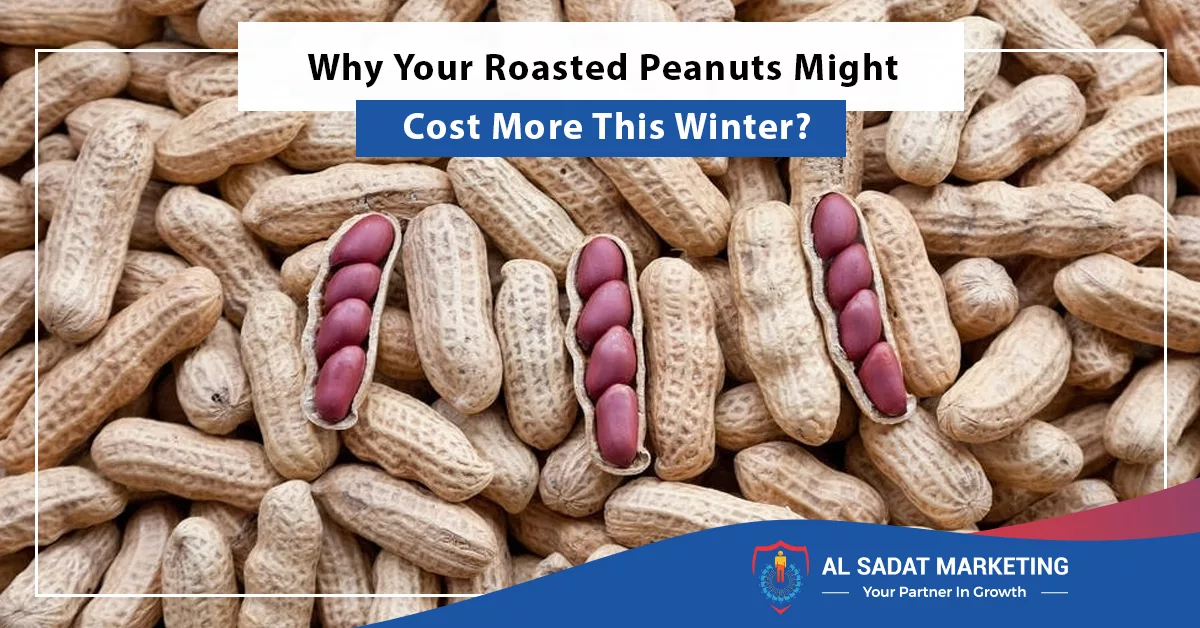People enjoy eating roasted peanuts when huddling under blankets during the winter months, but this year, that pleasure may come at a greater price because one of the less well-known cash crops has been struck by an increase in production costs and a climate cycle that is unfavourable to the producing zones.
Groundnuts, often known as peanuts, are a cash crop, which may surprise some people in urban areas, but its margins are on par with, if not larger than, those of sugarcane, potatoes, and corn. Surprisingly, no single crop provides comparable returns in Pothohar’s rain-fed regions. However, why are we discussing peanuts and any potential they may have? Short response? Huge.
Read More: CDA Distributes 7000 Seed Balls of Plants at Trail 5
Peanuts have come a long way in terms of distance and contribution to world food security and economic productivity since they first emerged in South American regions, specifically present-day Brazil, Peru, and Bolivia. The market is expected to grow to $107 billion by 2030 from its current worldwide size of over $87 billion. China is the world’s biggest producer of peanuts, followed by India, Nigeria, the United States, Indonesia, Argentina, Senegal, and Brazil.
Along with dominating production and exports, China and India account for more than 36% of the world’s demand for peanuts. The growing desire for ready-to-eat nut snacks, expanding export potential to Southeast Asia and Europe, increased demand for peanut oil in the pharmaceutical and personal care industries, and the growing popularity of protein-rich diets are all likely to drive the peanut oil market.
Because it is predominantly a leguminous crop, such as rice, sugarcane, and corn, it requires significantly less water because its root nodules can fix atmospheric nitrogen for it and it has deeper roots to fetch water. Additionally, given the current conditions, it fixes about 80% of the nitrogen needs from the environment on its own.
It can grow and adapt to various soil types, from sandy loam to light loam with a pH of 7-8, as long as the ground is soft enough to allow the roots to go deeper without negatively impacting production. Simply said, any soil that grows rice well may not be ideal for producing peanuts, and there are many other factors at play.
Pakistan’s production of peanuts increased dramatically over the last five years by 68 per cent, reaching 144,000 tons in 2021–22 on an area of 0.37 million acres, largely as a result of farmers shifting their focus to high-yield crops in response to the country’s uncertain economic future.
Read More: Over 1,600 Textile Factories Shut Down in Pakistan in 16 Months
Nearly 95% of the nation’s production is produced in Punjab alone, with 4% coming from Khyber Pakhtunkhwa and 1% from Sindh. In Punjab, almost all of the production is centred on eight districts in the Rawalpindi and Sargodha divisions, where abundant rainfall and scarce irrigation resources have sped up the adoption of the practice. However, this year’s agricultural production is probably going to be impacted by changing rainfall patterns and rising temperatures.
Although the weather was favourable in the beginning of the year, Manzoor Hussain, Senior Scientist and Incharge Ground Nut Research Station Attock said that this year’s groundnuts “have experienced serious stress during the filling stage due to the rise in temperature and decline in rains which can affect this year’s production”.
But he also pointed out that the crops are still healthy because the farmers used their drought-resistant types and strictly adhered to the production technology.
Peanut As An Oil Seed Crop:
You must be shocked to learn that Pakistan imports food for $8 billion, with edible oil accounting for approximately $4.5 billion of that total. Now let’s talk about peanuts before we go into the discussion of how and why Pakistan is an agricultural nation, how we got here, and why we don’t drill down some “common sense” in our policy-making circles.
Due to their high oleic content (40–50%) and unsaturated fatty acid content, peanuts are not only more storable but also help decrease blood lipid levels. For several years, the government has made an effort to persuade farmers to increase their production of canola and other Rabi oilseed crops. Even the inputs were subsidized, but the problem is that those policies conflicted with the wheat assistance.
On the other hand, farmers already know how to cultivate peanuts and have done so for decades; all they need is the right kind of incentive and regulatory support to help Pakistan reduce its reliance on imported edible oil. Without reserving those funds and putting them to more beneficial use and growth, there is no way we can advance.
Pakistan and China’s Shandong Rainbow Agriculture Institute are working together to introduce cultivars with a 75–80% oleic acid content and increase productivity. China is a terrific model to follow because it gets over a third (32%) of its edible oil needs from peanuts, but these efforts must be accelerated at a mass level on a priority basis because it is unquestionably one of the biggest economic concerns.
Cash Crop That Can Turn Lives Around
Our farmers have been influenced to plant a small number of highly intensive crops, making them more susceptible to climate change and pest and disease resistance, less by their economic situation and more by the government’s short-sighted policies.
If we take the average yield of 9.5 maunds (maund=40kg) per acre and the varied price range of Rs. 11,000 to Rs. 15,000 per 40 kg in the wholesale markets, the cost of peanut cultivation (as per government estimates) stands at Rs. 38,500 per acre. However, the average gross revenue can be roughly between Rs. 110,000 and Rs. 150,000 per acre. If the right attention is given to it, those huge profit margins might transform the lives of farming communities in the Pothohar region and elsewhere.
Read More: LHC Decision Allows Leasing of Land to Pak Army for Agriculture
It’s true that many people think this crop can only be grown in the Pothohar region and on sandy soils, but while sandy soils are best for rainy regions, it can also grow on irrigated soils all over the country. Although there has been a progressive shift in public opinion, Hussain continued, “more needs to be done to increase knowledge of it and concentrate on developing industries around its value-added goods, such as peanut butter, oil, flour, and snacks.
He added that they think farmers can produce up to 50 maunds per acre under irrigation, whereas they have previously produced up to 25 to 30 maunds per acre in rainfed areas. However, as I previously indicated, our average reported yield per acre is 9–10 maunds per acre. According to Hussain, this is because the majority of farmers continue to grow old desi varieties, which have poor yield potential and are not adaptable to changing climatic circumstances.
‘Attock-2019’ and ‘Fakhr-e-Bakhar’ are two of the most recent high-yielding, disease- and drought-resistant varieties introduced by the Ground Nut Research Station Attock, while a third advanced line is still in the experimental stages. However, Hussain noted that research institutions can only produce a certain amount of seeds.
Since it is a leguminous crop, as was already said, it receives the majority of the nutrients it needs from the soil and the water it receives contributes nitrogen, reducing the need for nitrogen fertilizers in the following crop. It is a package deal to be added to the toolkit for protecting the fertility of our soils and preparing our agriculture sector and rural communities for the effects of climate change.
Our farmers need to be made aware that growing these crops is not limited to rainfed regions, but those in central Punjab can also adopt them.
We just need to offer more options rather than putting all of our eggs in one basket to prevent our agricultural industry from contributing to climate change by monocropping on vast tracts of land, endangering the financial security of farmers and the entire nation.
You can also invest in other famous and most in demand housing societies, such as , Blue World City, Rudn Enclave, 7 Wonders City Peshawar, Taj Residencia, Kingdom Valley, New Metro City Gujar Khan, Forest Town Rawalpindi, University Town Rawalpindi, ICHS Town, Park View City Islamabad, Multi Gardens B17 Islamabad and Nova City Islamabad.
Al Sadat Marketing please contact 0331 1110005 or visit https://alsadatmarketing.com/
Few more real estate housing schemes which are trending now a days in Islamabad by including: Faisal Town Phase 2, Prism Town Gujar Khan, New City Paradise, Eighteen Islamabad, 7 Wonders City Islamabad, Capital Smart City, Silver City Islamabad, The Life Residencia, Faisal Town Islamabad, Islamabad Golf City, Islamabad Model Town and Marble Arch Enclave.
Al Sadat Marketing is an emerging Real Estate Agency headquartered in Islamabad, Pakistan. With over 10+ Years of experience, Al Sadat Marketing is providing its services and dealing all trending housing societies projects in different cities of Pakistan. Islamabad Projects, Rawalpindi Projects, Gujar Khan Projects, Burhan Projects, and Peshawar Projects etc.
Book Your Plot Now: +92 331 111 0005










